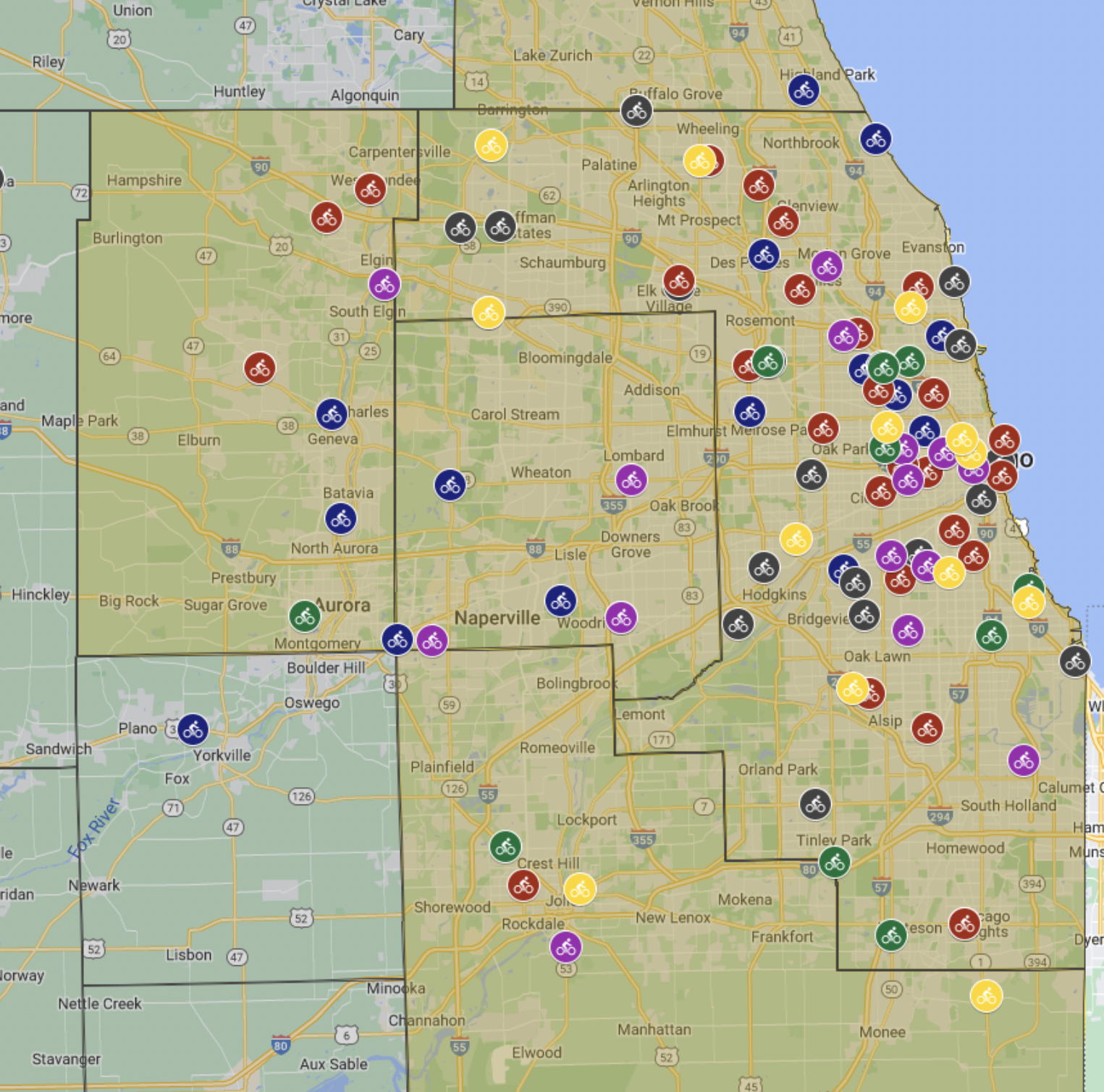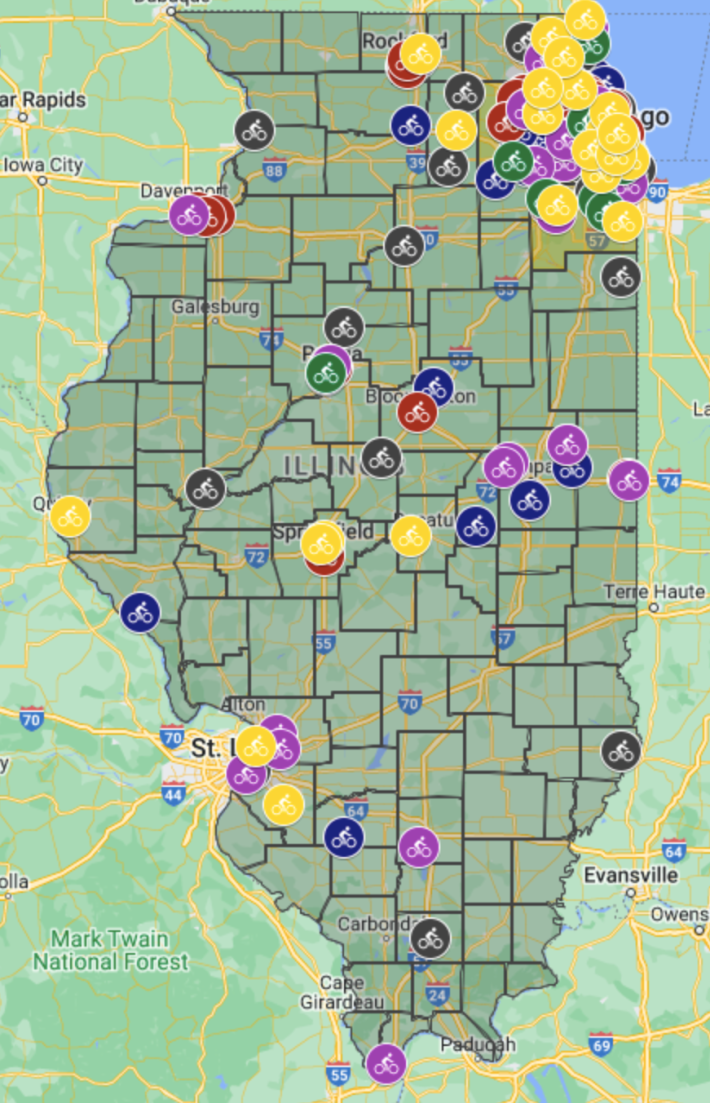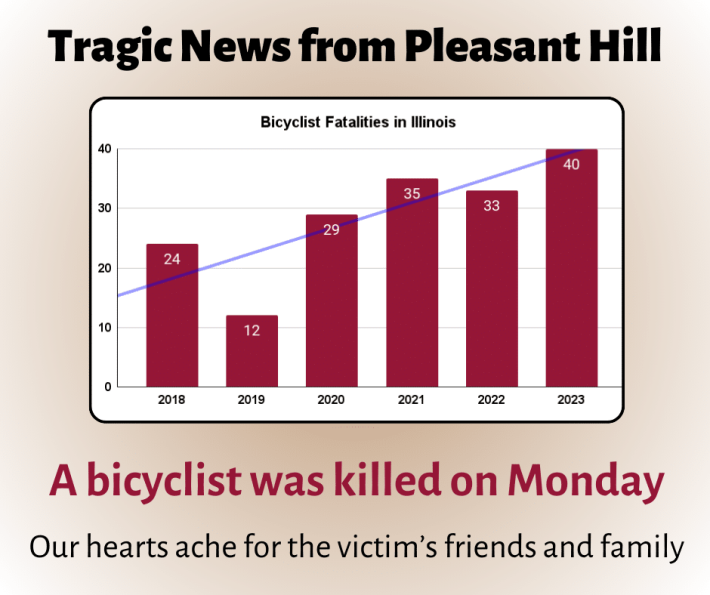“We’re all equally in danger”: Ride Illinois launches statewide bike fatality awareness campaign
The statewide bicycle advocacy organization recently announced its “Our Response to Fatal Crashes” campaign, an effort to raise awareness of the traffic violence crisis across Illinois.
3:55 PM CST on January 30, 2024

Close-up of Chicagoland from Ride Illinois’s statewide crash map.

The national epidemic of traffic violence and rise in fatalities—particularly of people outside the vehicles involved—has been worsening for the last five years. And the tragedies are not limited to dense urban areas; the state of Illinois experienced 40 fatal crashes for bicyclists in 2023, up from just 12 in 2019. Roughly one third of these took place outside Chicagoland.
Bicycle advocacy organization Ride Illinois recently announced the “Our Response to Fatal Crashes” campaign, an effort to raise awareness of the crisis statewide—especially in areas outside Chicagoland, which have few to no local bike advocacy groups. Ride Illinois recently added a map to their website—inspired, according to the announcement, by Streetsblog Chicago’s map of bike fatalities—tracking all fatal crashes in the state since 2018. We spoke with Dave Simmons, executive director of Ride Illinois about the campaign, and the threats bicyclists face on roadways across the Land of Lincoln.
Sharon Hoyer: Why did Ride Illinois choose to launch this advocacy effort in 2024?
Dave Simmons: It’s more that we’ve been talking about doing this and now gotten around to it. I used to work for Rand McNally making maps and I understand the visual impact a map can have. We created this map several months ago and requested data from IDOT about fatalities for the last five years. We imported into the Google My Maps and my initial reaction was wow, this is a big problem. Obviously, a lot of concentration of fatalities are in Chicagoland but it showed fatalities are happening all over.
We wanted to get the word out before the next unfortunate fatality. We didn’t want to jump on the publicity of a fatality; we wanted to say ahead of time this is something we’re going to do.
SH: Tell me a little about the strategy.
DS: We want to learn a little more about crashes. For example, one of the things we started doing when we began tracking fatalities in 2023 was looking at media articles, to understand more about the crashes and to look for any media bias or victim blaming. I think we’ll see this in crashes that happen outside Chicagoland. You read—typically short—media articles and they’re lacking something from the perspective of a bicyclist: why someone is there, why they were doing what they were doing. We want to raise the awareness that these tragedies are occurring. It’s not just a Chicago thing. We know Streetsblog Chicago, Bike Lane Uprising, Active Trans, Bike Grid Now—there’s plenty of orgs doing good work on this topic. If we can help outside Chicagoland, that would be a win for us.
I did a quick calculation: somewhere between 30 and 35 percent of fatalities are outside Chicagoland. At the same time, 30-35 percent of population of state is outside Chicagoland.
The U.S. Census Bureau estimates that the Chicago Metropolitan Statistical Area comprises 75 percent of the Illinois population. - Ed
SH: So, it’s pretty much proportional…

DS: In essence, it is proportional. We're [people who bike] all equally in danger. From Zion [near the Wisconsin border] to Cairo [the southernmost tip of the state] people have been killed. We shared the visual with the Secretary of State’s chief of staff. We’ve since decided to share the map on our website.
We were a little concerned about crossing the line with folks impacted by fatalities. It’s anonymous; we’re not stating names. We’re wondering if we should post obituaries, should we post photos? It’s been several months of discussion on this. We decided the facts are the facts. There will be a post on social media with a chart and probably a media link. IDOT includes make of the vehicle and perspective of motorist. What’s not included is the perspective of the person who was killed.
There was a young man who was killed, and the motorist said, “He just pulled out in front of me.” But how do we know that? Whatever data is captured in a crash report is the best we have. But we know there’s a story missing there. Through a little research we might be able to fill some holes. And push back if there’s victim blaming.

SH: How do you see that research taking place?
DS: Right now, it’s a giant spreadsheet. First thing we’ll do is pull in media links. From there we’ll look at what’s unique, and is there media bias? Maybe this becomes something that includes academic research. It’s premature to say that at this point, but we’re going to dig in as best we can now. We have a map out there and now we’re trying to fill in the holes on the fatalities that have happened. The data shows the gender and age of the bicyclist, the age and gender of the motorist, and make of vehicle. What kind of solutions could come from a deeper dive?
SH: You state Ride Illinois will make recommendations for improvements. I know it’s early, but what do you envision recommendations looking like?
DS: I’ll use an example. There was a young man recently killed biking home from school in Aurora. It was a right hook [when a motorist makes a right turn in front of the path of a moving bicyclist but it isn't clear to turn and the car hits the bicyclist]. The young man was on the sidewalk, it was a busy road, there was someone on the right turn lane. It was a green light—the young man crossed the intersection on the green light and the motorist made a turn. If we see a lot of fatalities from turns, is there an opportunity to limit right turns on red? Are there umbrella policies that can reduce or eliminate fatalities?
SH: According to IDOT, at this point in 2024 there have happily not been any bike fatalities as of yet—and maybe you’ll never have to test out this methodology on any new deaths, I hope—but 12 pedestrians have already been killed in the state. Have you considered including pedestrians in the project?
DS: If we had the opportunity to partner with someone, that would be a logical next step to include pedestrians. We’re a bike advocacy org, but so much of what we advocate for pedestrians benefit from and vice versa. That could absolutely be a next step, but for now we’ll focus on bicyclists. We’re going in knowing it will evolve. We’ll see what kind of impact it could make.
SH: What else do you want people to know?
DS: We want to hear from people. We know for some people we’re not going far enough. They’ll want us to call every official or march in Springfield. That’s where we would rely on folks in their community, to get to that level. This is new territory for Ride Illinois. We’re trying to make good trouble, which we didn’t do for many years. We want to ruffle some feathers. The level of awareness in Chicago and the organizations that jump in to support friends and families of victims is awe-inspiring. If we can at least get people talking, especially outside Chicagoland.
The other thing I should say is that we’ll do our best to get crash reports. It seems CPD [Chicago Police Department] is pretty willing to share crash reports, I don’t know that will be the case with other agencies. I think we’ll get a variety of responses.
Feedback is appreciated. It’s a little bit of building the plane while it’s flying.

Did you appreciate this post? Please consider making a tax-deductible donation to help Streetsblog Chicago keep publishing through 2025. Thank you.
Read More:
Stay in touch
Sign up for our free newsletter
More from Streetsblog Chicago
Johnson appoints one West Side pastor to CTA board, then nominates another West Side pastor for RTA board
Supporters argue that, despite his lack of transit expertise, Ira Acree’s social justice experience and political connections could be an asset for the RTA board.
Today’s Headlines for Thursday, April 26
The de-facto ban on riverwalk biking is back. What should we do about it?
In the short term, new signage is needed to designate legal areas for cycling on the path. In the long term CDOT should build the proposed Wacker Drive protected bike lane.


